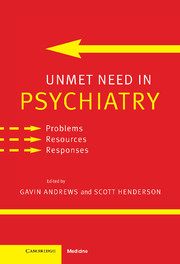Book contents
- Frontmatter
- Contents
- List of Contributors
- Preface
- Part I Unmet need: defining the problem
- Part II Unmet need: general problems and solutions
- Part III Unmet need: people with specific disorders
- Part IV Unmet need: specific issues
- Part V Unmet need: conclusion
- 29 A personal overview
- 30 Conclusion: the central issues
- Index
30 - Conclusion: the central issues
from Part V - Unmet need: conclusion
Published online by Cambridge University Press: 21 August 2009
- Frontmatter
- Contents
- List of Contributors
- Preface
- Part I Unmet need: defining the problem
- Part II Unmet need: general problems and solutions
- Part III Unmet need: people with specific disorders
- Part IV Unmet need: specific issues
- Part V Unmet need: conclusion
- 29 A personal overview
- 30 Conclusion: the central issues
- Index
Summary
It is only towards the end of the present millennium that mental disorders have come to take their place in health care. The burden they place on communities is now irrefutable. Psychiatric epidemiology has played a vital part in two ways in the process of achieving greater recognition for the needs of people with mental disorders. The use of epidemiological information for advocacy stands separately from scientific studies of what determines the onset and course of mental disorders. The problem of unmet need straddles both advocacy and science.
Until the first half of the twentieth century, people with more severe disorders were sent to specially built hospitals; and it was not recognized that a range of disabling mental disorders was also to be found in the general population. Epidemiology helped to change this. The community-based surveys pioneered by research psychiatrists such as Brugger (1933) in Germany, Srole, Langner, Michael, Opler & Rennie (1962) and the Leightons (Leighton, Harding, Macklin, Hughes & Leighton, 1963) in North America, Taylor & Chave (1964) in Britain, Hagnell & Öjesjö (1975) in Sweden, Dube (1968) in India, and Krupinski & Stoller (1971) in Australia helped to persuade policy makers that a sizeable fraction of the general population had clinically significant psychiatric symptoms and that these were accompanied by disablement of some economic significance. In retrospect, it is now possible to see that attitudes and beliefs about the needs of people with mental disorders have changed considerably during the later decades of the twentieth century. Indeed it was only in the second half of the twentieth century that psychiatry began to take a more appropriate place in medical education, and that the first professors of psychiatry were appointed in most medical schools.
Keywords
- Type
- Chapter
- Information
- Unmet Need in PsychiatryProblems, Resources, Responses, pp. 422 - 428Publisher: Cambridge University PressPrint publication year: 2000
- 8
- Cited by



